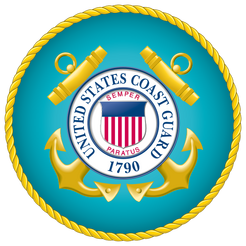
The US Coast Guard Insignia
The United States Coast Guard (abbreviated USCG stylised as U.S.C.G.) was established by an act of Congress on January 28 1915, by combining the Revenue Cutter Service, founded in August 1790, with the Life Saving Service, founded in 1878. The act stated that the Coast Guard should constitute a part of the military forces of the United States, operating in the style of the United States Navy. The Lighthouse Service, which was founded in 1789, was transferred to the Coast Guard on July 1 1939, as part of the President's Reorganization Plan No 11. [1]
Roles[]
The Service has 3 basic roles: Maritime Safety, Maritime Stewardship, and Maritime Security.[2] These roles grants the service a unique range of missions from aiding survivors of maritime and natural disaster, to engaging enemies on the United States coast. Following Germany's capture of Denmark in 1940 fear that Greenland's supply of cryolite (an important compound in the electrolytic processing of Aluminum) would fall under Nazi control prompted the U.S. State Department to recruit fifteen willing Coast Guardsmen to be discharged and subsequently hired to act as protection for the cryolite mine at Ivittuut. Three-inch naval deck guns were supplied to Greenland by the USCG cutters Campbell and Northland along with eight machine guns, fifty rifles, and thousands of rounds of ammunition.[3] During WWII the Coast Guard functioned as a watch for the enemy on U.S. coasts with a large role being looking for and engaging enemy German submarines in the Atlantic Theater. The Coast Guard aided in the transport of thousands of tons of supplies to Allied military forces and civilian populaces alike. Coast guardsman aided Navy personnel in providing fire support and manning landing vessels in amphibious operations throughout every US operations theater in WW2. Coast Guard dog patrols protected newly captured beaches and helped to root out hidden enemy snipers. Several Nazi weather stations and outposts in Greenland were also seized and later re-purposed by Coast Guard personnel in 1942 and 1943 to help provide accurate weather reports for the Allied Air Command. The Coast Guard also rescued survivors from naval vessels near the U.S coast whether it be attacked merchant ships or sunken U-Boats.[4] [5] During the lead-up to WW2 it fell under the purview of the Department of Treasury before being temporarily moved under the Department of the Navy for the duration of the war. The Coast Guard still operates today having been moved first under the Department of Transportation in 1967 and then later to the newly created Department of Homeland Security on 1 March 2003 (Homeland Security Act Public Law No. 107-296).
Organization[]
For administration and operational purposes, the United States and her territorial waters - including territories and insular possessions, but excluding the Philippine Islands - are divided into 13 districts. Each of these comes under the command of a district commander, operating directly under the Coast Guard Commandant.[1]
Personnel[]
Coast Guard members wear uniform similar to members of the U.S. Navy. Officers have a gold shield instead of a star on their sleeves, and their cap badge features an eagle with a silver shield on its breast, and grasping a horizontal foul anchor in its talons. A shield is also worn on the sleeves of the men.[6]
Aviation[]
By 1945, the Coast Guard had 10 air stations in operation, located at Salem, Massachusetts; Charleston, South Carolina; New York, New York State; Miami, Florida; St Petersburg, Florida; Biloxi, Mississippi; San Diego, California and San Francisco, California.[6]
References[]
- ↑ 1.0 1.1 McMurtrie, Francis E. (Editor) Jane's Fighting Ships of World War 2. Tiger Books International. ISBN 0517679639 Page 307
- ↑ 6 U.S.C. § 468
- ↑ http://www.uscg.mil/history/articles/USCGatWar-GreenlandPatrol.pdf
- ↑ http://www.uscg.mil/History/ww2index.asp
- ↑ USCG Film 1945 "On Foreign Shores" https://www.youtube.com/watch?v=IEQnbjhVL6M
- ↑ 6.0 6.1 Jane's Fighting Ships of World War 2. Page 308
